
Clarice Cliff for Newport Pottery Dinner Set, 'Honey Dew' Pattern
Clarice Cliff for Newport Pottery. A part dinner set 'Honey Dew ' pattern. 2 platters, 8 plates, a creamer and a lidded sugar bowl circa 1930

Clarice Cliff Bizarre Sugar Bowl 'Delecia' Pattern, c. 1930
Clarice Cliff (British, 1899-1972), Bizarre sugar bowl, c. 1930, 'Delecia' pattern, factory stamps underneath, some small chips (A/F), height 10 cm. Provenance: Private Collection, Sydney

Clarice Cliff Bizarre and Fantasque Sugar Bowl and Preserve Pot
Clarice Cliff (British, 1899-1972), Bizarre sugar bowl and Fantasque preserve pot, 'Orange' pattern sugar bowl, printed factory mark to base 'Hand painted Bizarre by Clarice Cliff Newport Pottery England' minor loss of paint, chips to lid, together with…

Clarice Cliff Bizarre Lucerne Cruet Set, c. 1930, Provenance Sydney
Clarice Cliff (British, 1899-1972), Bizarre three piece cruet set, c. 1930, 'Applique Lucerne' pattern, comprising salt, pepper and mustard pot, shakers marked 'Bizarre by Clarice Cliff' with hand painted 'Applique', pot with lid marked 'Hand painted…
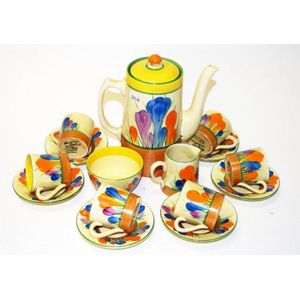
Clarice Cliff Bizarre "Crocus" Coffee Set with Damaged Pieces
Clarice Cliff Bizarre ''Crocus'' coffee set to include coffee pot, six each coffee cans & saucers, cream & sugar bowl. Pot 20 cm high. Nb one cup and one saucer damaged.

1934 Eva Crofts for Clarice Cliff Bizarre Milk Jug Set
A rare circa 1934 Eva Crofts for Clarice Cliff 'Art in Industry' Bizarre milk jug and sugar bowl, of Bonjour shape, gilt and blue concentric lines, black printed mark. Height 6 cm
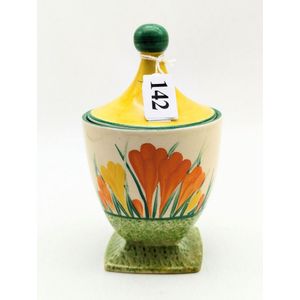
Clarice Cliff 'Crocuss' Sugar Bowl with Hand-Painted Flowers
Clarice Cliff sugar bowl, 'Crocuss' pattern decorated with hand painted flowers (stained and lid repaired) by Newport Pottery, height 14 cm
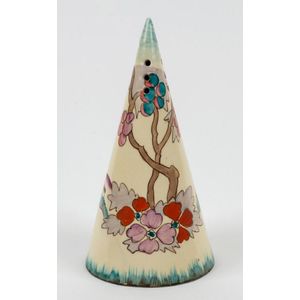
Clarice Cliff Art Deco Salt Pot
Clarice Cliff English Art Deco porcelain salt pot, circa 1930, black factory mark 'Clarice Cliff, Wilkinson Ltd. England', 14 cm high

Hand-painted Clarice Cliff Crocus Tea Set with Repaired Sugar Bowl
A hand painted Clarice Cliff Crocus pattern tea suite comprising coffee pot, jug - large crack, smaller jug, teacup and saucer trio, sugar bowl-repaired to rim

Clarice Cliff Crocus Salt & Pepper Shakers, 1930s
A pair of Clarice Cliff 'Crocus' salt and pepper shakers, 1930s, hand painted pillar shakers with marks for Newport Pottery and design title underside, 7 cm high
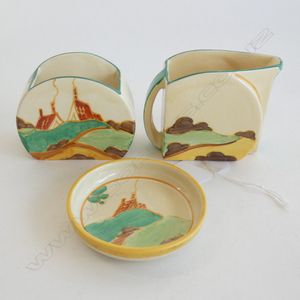
Clarice Cliff Fantastique Jug and Sugar Bowl Set
A Clarice Cliff Bonjour shape Fantastique jug and sugar bowl, along with small round dish, diameter 7.5 cm. With Farmhouses 'Secrets' pattern c.1933 -37

Clarice Cliff Sunburst Demitasse Set
A Clarice Cliff Bizarre demitasse sugar bowl and creamer, conical shape in Sunburst pattern, diameter 7.5 cm

Clarice Cliff Lorna Condiment Set
A Clarice Cliff three-piece Lorna condiment set, conical form, comprising salt, pepper and mustard. Unmarked. The tallest height 8 cm.

Clarice Cliff Nasturtiums Sifter
A Clarice Cliff Bizarre Nasturtiums conical sifter, black printed mark to base, height 13 cm.

Sunshine Bizarre Sugar Bowl by Clarice Cliff
Clarice Cliff sunshine Bizarre sugar bowl height 6.5 cm

Clarice Cliff Pansies Sugar Sifter
Clarice Cliff Bizarre 'Pansies' sugar sifter, of bonjour shape, decorated with pansies in tones of yellow, pink, green and blue, height 12.5 cm

Clarice Cliff Celtic Harvest Sugar Basin & Cover
Clarice Cliff Celtic harvest pattern sugar basin with original chrome plated cover and spoon
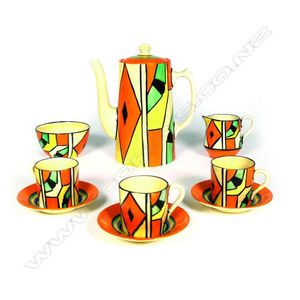
Clarice Cliff Bizarre 'Diamonds' Coffee Set
A c1930 Clarice Cliff Bizarre 'Diamonds' part coffee set, includes 'tankard' form coffee pot with restored lid, sugar, and cream plus three coffee cans and saucers, one can restored, one with crazing. The coffee pot height 19 cm.

Clarice Cliff Hand-Painted Sugar Caster
A Clarice Cliff hand painted conical sugar caster, of typical form, 'Handpainted Bizarre by Clarice Cliff Newport Pottery' mark to base, 14.5 cm high
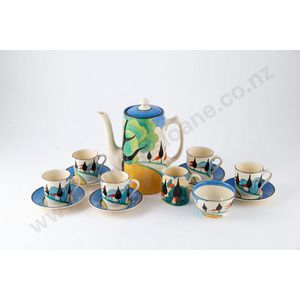
Clarice Cliff Bizarre May Avenue Coffee Set
Exceptionally rare Clarice Cliff Bizarre May Avenue pattern coffee set, comprising, tapering coffee pot, sugar bowl and cream jug, 6 saucers and 5 cylindrical coffee cans, one with rim chip, one base chip, c1933

Clarice Cliff Bizarre Lucerne Cruet Set
Clarice Cliff, Bizarre three piece cruet set, c. 1930, applique Lucerne pattern, comprising salt, pepper and mustard pot, shakers marked 'Bizarre by Clarice Cliff' with hand painted 'Applique', pot marked 'Hand painted Bizarre by Clarice Cliff Newport…

Clarice Cliff Rhodanthe Cruet Set with Imperfections
Clarice Cliff Bizarre 3 piece cruet set 'Rhodanthe' pattern, comprising of a mustard pot maker's mark to base and 2 salt / pepper shakers no maker's mark, 6.5 cm - 8 cm high the mustard pot with chip to top rim and salt shaker with repair to bottom rim

Clarice Cliff Collection: Hydrangea, Lorna, Beehive and Floral Decoration
Four Clarice Cliff items, includes 'Hydrangea' cigarette and match holder, shape 463, 'Lorna' salt and pepper in the Lynton shape and 'Beehive' preserve pot base with floral decoration.
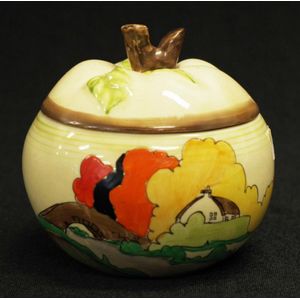
Clarice Cliff 'Tree House' Sugar Bowl with Lid
Clarice Cliff 'Tree House' lidded sugar bowl marked to base, height 10 cm
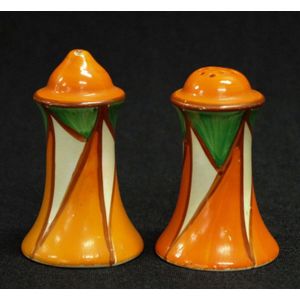
Hand-painted Clarice Cliff Bizarre Salt & Pepper Shakers
Pair Clarice Cliff 'Bizarre' salt & pepper shakers hand painted, marked to bass, salt shaker with small chip to outlet hole, height 8.5 cm, each.

Clarice Cliff Nasturtium Cream & Sugar Set
A Clarice Cliff Bizarre cream and sugar, Nasturtium pattern, Bonjour shape, printed mark to base.

Clarice Cliff Circus Sugar Bowl
Clarice Cliff sugar bowl early 20th century, Wilkinson Ltd Pottery, hand painted circus design by Dame Laura knight, printed factory base mark produced in Bizarre by Clarice Cliff, Wilkinson Ltd, England Copyright Reserved, first edition 1934, 6 x 12.5 cm

Clarice Cliff Bizarre Rhodanthe Sugar Sifter
Sugar sifter early 20th century, c1930, Wilkinson Pottery, decorated with Clarice Cliff Bizarre Rhodanthe design, black printed factory base mark, height 14 cm, (hairline to base)

Clarice Cliff Bizarre Sugar Bowl with Lid Chips, 10cm
A Clarice Cliff Bizarre sugar bowl, chips to lid, height 10 cm

Clarice Cliff Honeyglaze Sugar Caster - 14cm Height
A Wilkinson's 'Honeyglaze' sugar caster, Clarice Cliff conical shape, height 14 cm.

Clarice Cliff Crocus Cruet Set
Clarice Cliff Crocus pattern cruet set, salt & pepper & mustard pot with lid

Clarice Cliff Wedgwood Sugar Castors with House and Bridge
Bizarre by Clarice Cliff Wedgwood pair of 'House With Bridge' sugar castors, circa 1996, stamped 'Bizarre by Clarice Cliff, Wedgwood, Clarice Cliff, Made In England, Based Upon An Original, Hand Painted', 13.5 cm high

Clarice Cliff Anemone Sugar Bowl
Clarice Cliff sugar bowl c.1937, in anemone pattern, decorated with flower heads, in tones of blue, green, yellow and pink, printed factory mark to base, depth 8.5 cm
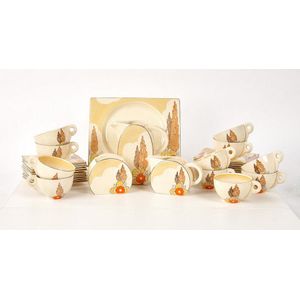
Clarice Cliff Bizarre Capri Set (37 pieces)
A large set of Clarice Cliff Bizarre Capri, 11 cups, 11 saucers, 11 plates, 1 sugar bowl, 1 large jug, 1 smaller creamer and 1 serving plate (37 pieces), height of largest jug 16.5 cm

Clarice Cliff Bizarre Crocus Sugar Castor
Clarice Cliff Bizarre 'Crocus' sugar castor of conical form, 13.5 cm high
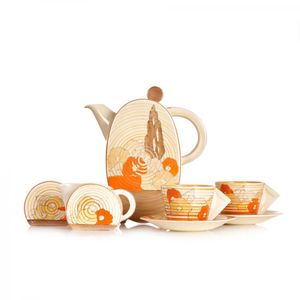
Clarice Cliff Capri Coffee Set, 1935
Seven piece Clarice Cliff Bizarre Capri coffee set c1935, coffee pot, two conical cups & saucers, milk jug and sugar bowl, coffee pot height 20 cm

Clarice Cliff Crocus Sugar Bowl with Lid
Vintage Clarice Cliff Bizarre 'Crocus' sugar bowl, with lid, marked to base, with Reg. No. 776245. Height 10 cm approx.

Clarice Cliff Leaf Tree Salt and Pepper Shakers
A pair of Clarice Cliff 'Leaf tree' salt and pepper shakers, circa early 1930s, in orange, purple and blue colours upon a stippled chocolate cafe au lait ground; with Clarice Cliff Newport marks underside, height 8.5 cm, 8 cm
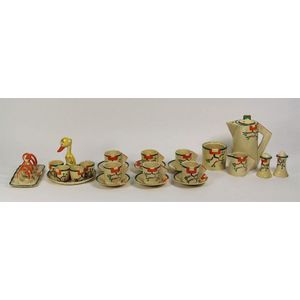
Clarice Cliff Bizarre Ravel Breakfast Set - 23 Pieces
Clarice Cliff Bizarre Ravel part breakfast set, Wilkinson Ltd, to include coffee service for six creamer and a sugar (missing a lid) egg cruet with duck handle, toast rack and salt and pepper (pepper with damage) all in used condition, 23 pieces

Clarice Cliff Capri Sugar Sifter, c.1930s
A Clarice Cliff Bizarre Capri sugar sifter, c.1930's printed mark Clarice Cliff Newport pottery stamp height 13.8 cm

Clarice Cliff Bizarre Sugar Sifters (Set of 3)
Clarice Cliff, Three 'Bizarre' Conical Sugar Sifters, Pastel Melon', 'Viscaria', and 'Rudyard' pattern, printed factory marks to bases 'Hand Painted Bizarre by Clarice Cliff Newport Pottery England', one missing cork stopper (2), height 14 cm. Provenance:…

Clarice Cliff Bizarre Sugar Sifters, Orange Erin & Oranges/Lemons
Clarice Cliff, Two 'Bizarre' Conical Sugar Sifters, Orange Erin' and 'Oranges and Lemons' pattern, printed factory marks to bases 'Hand Painted Bizarre by Clarice Cliff Newport Pottery England', one missing cork stopper (2), height 14 cm. Provenance:…

Clarice Cliff Bizarre Sugar Sifter, Fragrance Pattern
Clarice Cliff, Bizarre' Conical Sugar sifter, c. 1935, Fragrance' pattern, printed factory marks to base 'Hand Painted Bizarre by Clarice Cliff Wilkinson Ltd England', with original cork stopper, height 14 cm. Provenance: Private Collection, WA

Clarice Cliff Bizarre Sunshine Sifter, Printed Marks, 14cm Height
A Clarice Cliff Bizarre conical sifter, in the 'Sunshine' pattern. Printed marks. Height 14 cm

Clarice Cliff 'Crocus' Sugar Bowl with Yellow Lid
Clarice Cliff 'Çrocus' lidded sugar bowl, floral decorated with yellow lid. Marked to base and Regn. No. 770245. (As inspected: small rim chip to corner of lid). Height 11 cm (total).

Autumn Leaf Honey Glaze Sifter by Clarice Cliff
Clarice Cliff honey glaze conical sifter autumn leaf pattern

Clarice Cliff Blue Chintz Sugar Castor with Silver Cover
Clarice Cliff Fantasque Bizarre 'Blue Chintz' sugar castor painted in green, blue & pink tones, with a silver plated cover, stamped to the base. Height 15 cm

Clarice Cliff Harvest Condiment Set
A Clarice Cliff two section condiment set, harvest pattern, 11 cm high

Clarice Cliff Bizarre Garden Wares Set
Three Clarice Cliff Bizarre 'My garden' wares: a bowl, sugar shaker and a small Candleholder$1930-35, a tan drip glazed yellow bowl and a matching pillar shaker, both with moulded floral bases in exuberant colours; and a similar domed candleholder;…

Clarice Cliff Bizarre 'Aura' Sugar Bowl and Saucer
A Clarice Cliff Bizarre 'Aura' covered sugar bowl and saucer, the green 'Aura' bowl with triangular handles and decorated to the borders with Prussian blue, emerald and tan colours upon a cream ground; Bizarre Wilkinson backstamps underside, height 10.5…

Clarice Cliff 'Leaf Tree' Salt & Pepper Shakers
A pair of Clarice Cliff 'Leaf tree' salt and pepper shakers, circa early 1930s, in orange, purple and blue colours upon a stippled chocolate cafe au lait ground; with Clarice Cliff Newport marks underside, height 8.5 cm, and 8 cm

Clarice Cliff Bizarre Vase and Sugar Shaker Set
A Clarice Cliff Bizarre 'Rodanthe' vase and sugar shaker$1930-35, the ovoid vase and 'Bonjour' shape sugar shaker both hand painted over glaze with flowering trees in autumnal colours on a cream ground; Bizarre Wilkinson backstamps underside, height 13 cm…

Clarice Cliff Honeyglaze Dinner Set
Extensive Clarice Cliff 'Honeyglaze' dinner set, to include 6 dinner plates, 6 entree plates, 6 side plates, 6 dessert bowls, 6 soup bowls, 6 coffee cups and saucers, coffee pot sugar and creamer, gravy boat and saucer, 3 piece condiment set, dish, lidded…

Clarice Cliff Garden Sugar Sifter (660)
Clarice Cliff 'My garden' sugar sifter, shape 660. Height 15 cm
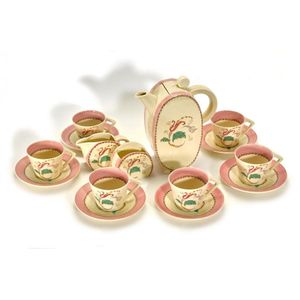
Art Deco Bonjour Coffee Service by Clarice Cliff
Clarice Cliff, A Bonjour porcelain coffee service, circa 1930, modelled in Art Deco geometric forms and comprising: a coffee pot and cover, sugar, milk jug and six coffee cans and saucers, painted with stylised scattering foliage in pinks, orange and…

Sailboat Sugar Caster by Clarice Cliff
Clarice Cliff Bizarre Fantasque conical sugar caster painted with sailboat pattern

Clarice Cliff 'Fantasque' Preserve Pot with Umbrellas and Rain Pattern
Clarice Cliff 'Fantasque' preserve pot 'Umbrellas and Rain' pattern, some paint losses, 7.5 cm high, 7.8 cm diameter

Clarice Cliff Bizarre Sugar Bowl - 8cm Diameter
A Clarice Cliff 'Bizarre ' sugar bowl, approx 8 cm diameter

Clarice Cliff Bizarre Sugar Basin with Lid
Clarice Cliff Bizarre 'My Garden' pattern lidded sugar basin

Clarice Cliff Windbells Sugar Sifter
A Clarice Cliff Bizarre, Fantasque, Windbells. Conical shape, sugar sifter, c.1930's. Hand painted ceramic. Printed factory marks to base. Height 14 cm

Clarice Cliff Bizarre Sugar Sifter, 1936
Clarice Cliff, Bizarre' Sugar sifter, c. 1936, Brookfields' pattern, 'Lynton' shape, printed factory marks to base 'Hand Painted Bizarre by Clarice Cliff Newport Pottery England' (A/F), height 12.5 cm

Clarice Cliff Duck Cruet Tray
Clarice Cliff, Bizarre' Duck Cruet Tray, c. 1929, Keyhole' pattern, printed factory marks to base 'Hand Painted Bizarre by Clarice Cliff Newport Pottery England, height 13 cm

Clarice Cliff Harvest Time Sugar Pot with Lid
Large Clarice Cliff 'harvest time'lidded sugar pot height 11.5 cm approx

Clarice Cliff Hollyhocks Salt and Pepper Set
A 'Hollyhocks' salt bowl and pepper pot by Clarice Cliff, circa 1937-39, the tapering bullet shaped pepper pot and tapering ribbed salt both decorated with coloured hollyhocks in a garden setting, with pale blue mottled clouds and blue, yellow and tan…

Clarice Cliff Crocus Porcelain Sugar Bowl, 1930s
A Clarice Cliff 'Crocus' patterned English porcelain sugar bowl, circa 1930s. 4 cm high, 7 cm diameter

1935 Clarice Cliff Bizarre Tourmina Sugar Sifter
A Clarice Cliff Bizarre 'Tourmina' conical sugar sifter, circa 1935high

1935 Clarice Cliff Bizarre Coral Firs Sugar Sifter
A Clarice Cliff Bizarre 'Coral Firs' conical sugar sifter, circa 1935high

Clarice Cliff Bizarre Sunrise Preserve Pot (8.5cm)
A Clarice Cliff Bizarre 'Sunrise' cylindrical preserve pot, circa 1929. 8.5 cm high
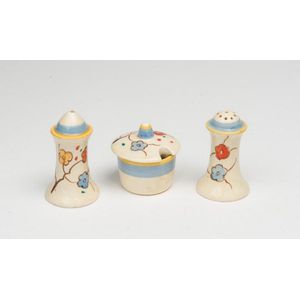
1935 Clarice Cliff Floral Cruet Set with 8.5 cm Salt Shaker
A Clarice Cliff floral cruet set, circa 1935. The salt shaker 8.5 cm high

Clarice Cliff Bizarre Pansy Sugar Sifter
A Clarice Cliff Bizarre 'Pansy' conical sugar sifter, circa 1935. 14.2 cm high

Clarice Cliff Beehive Preserve Pot
A Clarice Cliff 'Original Bizarre' Beehive Preserve pot, circa 1928. 9.5 cm high

Clarice Cliff Bizarre Tiger Tree Beehive Pot, 1928
A Clarice Cliff Bizarre 'Tiger Tree' Beehive Preserve pot, circa 1928. 9.5 cm high

Clarice Cliff Bizarre Green Chintz Beehive Preserve Pot
A Clarice Cliff Bizarre 'Green Chintz' Beehive preserve pot, circa 1930. 9.5 cm

Clarice Cliff Bizarre Preserve Pot (1929)
A Clarice Cliff 'Original Bizarre' cylindrical preserve pot, circa 1929. 8.5 cm high

Clarice Cliff Bizarre Autumn Pastel Preserve Pot
A Clarice Cliff Bizarre 'Autumn Pastel' cylindrical preserve pot, circa 1932. 9.5 cm high

Clarice Cliff Bizarre Preserve Pot, 1929
A Clarice Cliff Bizarre 'Sunray & Leaves' cylindrical preserve pot, circa 1929

Clarice Cliff Bizarre 'Orange Autumn' Sugar Sifter (1935)
A Clarice Cliff Bizarre 'Orange Autumn' conical sugar sifter, circa 1935high

Clarice Cliff Bizarre 'Broth' Preserve Pot, 1928
A Clarice Cliff Bizarre 'Broth' cylindrical preserve pot, circa 1928. 9.5 cm

Clarice Cliff Bizarre Sugar Sifter, 1930s
A Clarice Cliff Bizarre sugar sifter, c.1930's conical shape, slight AF - base, with 'Bizarre by Clarice Cliff' printed backstamp. Height 13.5 cm

Clarice Cliff Crocus Mustard Pot, Salt & Pepper Set
A Clarice Cliff Bizarre 'Crocus' pattern mustard pot, salt and pepper, the pot with original lid.

Clarice Cliff Bizarre Tralee Sugar Shaker
A Clarice Cliff Bizarre 'Tralee' sugar shaker, c.1935. Hand painted ceramic. Bonjour shape. Printed factory marks to base. Height 12.6 cm

Clarice Cliff Bizarre Sugar Bowl, 1930
A Clarice Cliff Bizarre small sugar bowl, English, circa 1930. 5 cm high, 7 cm diameter

Limited Edition Wedgwood Clarice Cliff Sugar Caster
A limited edition Wedgwood Clarice Cliff bizarre sugar caster, English, circa 1997. 13.8 cm high

Blue Chintz Covered Sugar Bowl by Clarice Cliff
A Clarice Cliff bizarre Blue Chintz covered sugar bowl, English, circa 1930 9.5 cm high

Clarice Cliff Bizarre Dinner Set with 47 Pieces
Clarice Cliff the Biarritz Royal Staffordshire 'Bizarre' dinner set green and yellow banded pattern, printed factory marks to base, impressed '34', two platters, two lidded tureens, four dinner plates, six soup plates, six dessert plates, twelve side…

Rare Clarice Cliff Lucerne Art Deco Coffee Set
Rare Clarice Cliff Art Deco coffee set, conical shape, Applique range, Lucerne pattern. Comprising coffee pot, six each cups and saucers, cream and sugar. Excellent original condition. Small glaze loss rim of sugar

Bizarre Field Flowers Tea Set by Clarice Cliff
Clarice Cliff, 'Bizarre' Eva Crofts for Clarice Cliff Bachelor tea set 'Field Flowers' pattern, 'Bonjour' shape, printed factory marks to base 'Designed by Eva Crofts Produced in Bizarre by Clarice Cliff Wilkinson England', cup, saucer, side plate, tea…

Clarice Cliff Bizarre Coffee Set
Clarice Cliff, 'Bizarre' Eva Crofts for Clarice Cliff coffee set, c.1934 'Field Flowers' pattern, 'Bonjour' shape, printed factory marks to base 'Designed by Eva Crofts Produced in Bizarre by Clarice Cliff Wilkinson England', six cups, six saucers, coffee…

Clarice Cliff Bizarre Damask Rose Tea Set
Clarice Cliff, 'Bizarre', afternoon tea set 'Damask Rose' pattern, 'Daffodil' shape, printed factory marks to base 'Damask Rose Hand Painted Bizarre by Clarice Cliff Newport Pottery England', six cups, six saucers, six side plates, two luncheon plates,…

Clarice Cliff 'Pink Pearls' Tea Set
Clarice Cliff, 'Bizarre' Bachelor tea set 'Pink Pearls' pattern, 'Bonjour' shape, printed factory marks to base 'Hand Painted Bizarre by Clarice Cliff Wilkinson England', cup, saucer, side plate, tea pot, creamer, sugar bowl (6) Measurements tea pot…

Clarice Cliff Goldstone Bizarre Coffee Set
Clarice Cliff, 'Goldstone Bizarre' coffee set 'Goldstone' pattern, printed factory marks to base, 'Hand Painted Goldstone Bizarre by Clarice Cliff Wilkinson Pottery England', six cups, six saucers, coffee pot, creamer, sugar bowl (A/F) (15) Measurements…
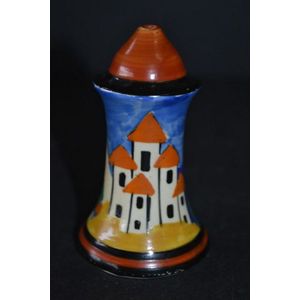




 Loading more...
Loading more...